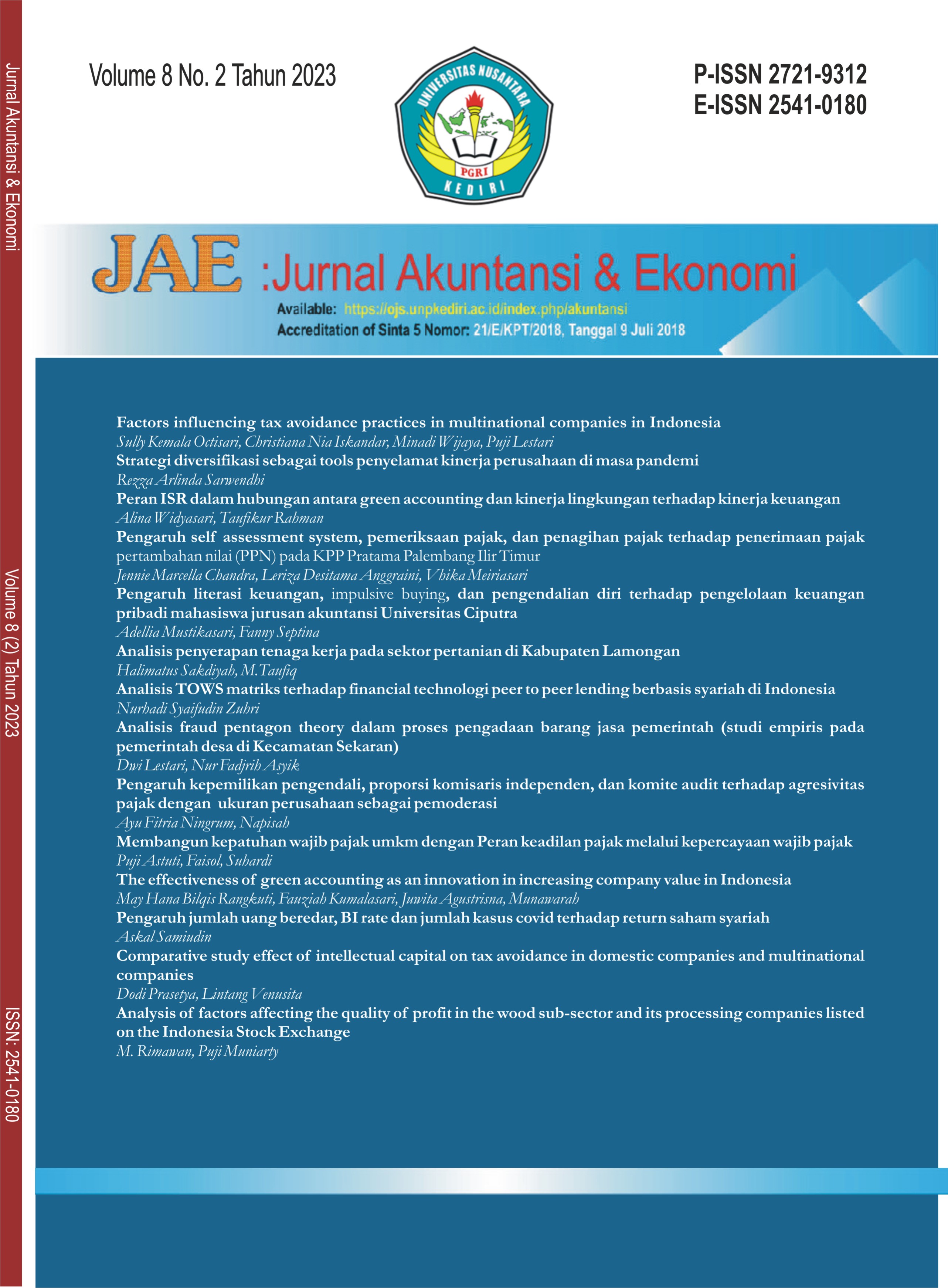ANALYSIS OF FACTORS AFFECTING THE QUALITY OF PROFIT IN THE WOOD SUB-SECTOR AND ITS PROCESSING COMPANIES LISTED ON THE INDONESIA STOCK EXCHANGE
DOI:
https://doi.org/10.29407/jae.v8i2.20365Keywords:
Earnings quality, likuidity, profitability, leverage, company size, investment opportunity set.Abstract
This study aims to analyze the effect of likuidity, profitability, leverage, firm size and Investment Opportunity Set on earnings quality. The sampling technique was carried out using saturated sampling. The samples in this study are 4 companies in the wood and processing sub-sector that are listed on the Indonesia Stock Exchange (IDX) from 2019 to 2021. The data in this study were processed using the SPSS application with multiple linear regression analysis methods. The hypothesis testing method uses a significance level of 5% or 0.05. The results showed that 1) the likuidity variable has an effect on earnings quality. 2) the profitability variable has no effect on earnings quality, 3) the leverage variable has an effect on earnings quality, 4) the firm size variable has an effect on earnings quality, and 5) the investment opportunity variable has an effect on earnings quality.6) the result silmultan has an effect earning quality
References
Anam, C., & Zuardi, L. R. (2018). Analisis Rasio Likuiditas, Rasio Solvabilitas, dan Biaya Operasional Terhadap Pajak Penghasilan Badan Terutang (Sektor Pertambangan di Bei Tahun 2011-2016). Margin Eco, 2(1), 43–68.
Anjelica, K., & Prasetyawan, A. F. (2014). Pengaruh Profitabilitas, Umur Perusahaan, Ukuran Perusahaan, Kualitas Audit, dan Struktur Modal Terhadap Kualitas Laba. Jurnal Ultima Accounting, 6(1), 27–42.
Arisonda, R. (2018). Pengaruh Struktur Modal, Likuiditas, Pertumbuhan Laba, Ukuran Perusahaan, dan Invesment Opportunity Set (IOS) Terhadap Kualitas Laba pada Perusahaan Manufaktur yang Terdaftar di Bei. ADVANCE, 5(2), 42–47.
Darmayanti, Y., & Fauziati, P. (2019). Pengaruh Investment Opportunity Set dan Corporate Governance Terhadap Kualitas Laba ( Studi Empiris Pada Perusahaan Manufaktur yang Listing di Bei tahun 2011-2015. Reviu Akuntansi Dan Bisnis Indonesia, 3(2), 124–138.
Dewi, I. G. A. S., Endiana, I. D. M., & Arizona, P. E. (2020). Pengaruh Leverage, Investment Opportunity Set (Ios), dan Mekanisme Good Corporate Covernance Terhadap Kualitas Laba pada Perusahaan Manufaktur di Bursa Efek Indonesia. Jurnal Kharisma, 2(1), 125–136.
Herninta, T., & Ginting, R. S. B. (2020). Faktor-faktor yang Mempengaruhi Kualitas Laba. ESENSI: Jurnal Manajemen Bisnis, 23(2), 155–167.
Kepramareni, P., Pradnyawati, S. O., & Swandewi, N. N. A. (2021). Kualitas Laba dan Faktor-faktor yang Berpengaruh (Studi Kasus pada Perusahaan Manufaktur Tahun 2017-2019). Jurnal Ekonomi, Bisnis Dan Akuntansi, 20(2), 170–178.
Mahendra, I. P. Y., & Wirama, D. G. (2017). Pengaruh Profitabilitas, Struktur Modal, dan Ukuran Perusahaan pada Earnings Response Coefficient. E-Jurnal Akuntansi Universitas Udayana, 20(3), 2566–2591.
Murniati, T., Sastri, I. I. D. A. M. M., & Rupa, I. W. (2018). Faktor-faktor yang Mempengaruhi Kualitas Laba pada Perusahaan Manufaktur yang Terdaftar di Bei Tahun 2012-2016. Jurnal Kumpulan Riset Akuntansi, 10(1), 89–101.
Novika, W., & Siswanti, T. (2022). Pengaruh Perputaran Kas, Perputaran Piutang dan Perputaran Persediaan Terhadap Profitabilitas (Studi Empiris Perusahaan Manufaktur - Subsektor Makanan dan Minuman yang Terdaftar di Bei Periode Tahun 2017-2019). Jurnal Ilmiah Mahasiswa Akuntansi, 2(1), 43–56.
Putri, R. A., & Setiawan, M. A. (2019). Pengaruh Investment Opportunity Set (IOS), Kebijakan Dividen, dan Opportunistic Behavior Terhadap Nilai Perusahaan (Studi Empiris pada Perusahaan Manufaktur yang Terdaftar di Bursa Efek Indonesia Tahun 2015-2018). Jurnal Eksplorasi Akuntansi, 1(3), 1392–1410.
Sa’diya, H., Maslichah, & Afifudin. (2019). Pengaruh Pendapatan Usaha dan Beban Operasional Terhadap Laba Bersih pada Perusahaan Tekstil dan Garmen yang Terdaftar di Bursa Efek Indonesia Periode Tahun 2013-2017. Jurnal Riset Akuntansi, 08(10), 56–67.
Sadiah, H., & Priyadi, M. P. (2015). Pengaruh Leverage, Likuiditas, Size, Pertumbuhan Laba dan Ios Terhadap Kualitas Laba. Jurnal Ilmu & Riset Akuntansi, 4(5), 2–21.
Safitri, R., & Afriyenti, M. (2020). Pengaruh Ukuran Perusahaan, Likuiditas, Dan Konservatisme Akuntansi Terhadap Kualitas Laba. Jurnal Eksplorasi Akuntansi, 2(4), 3793–3807.
Situmorang, C. V. (2017). Analisis Faktor-faktor yang Mempengaruhi Kualitas Laba Studi Kasus pada Sub Sektor Manufaktur di Bursa Efek Indonesia. Jurnal Kewiraushaan, 3(2), 50–58.
Soly, N., & Wijaya, N. (2017). Faktor-faktor yang Mempengaruhi Kualitas Laba pada Perusahaan Manufaktur. Jurnal Bisnis Dan Akuntansi, 19(1), 47–55.
Sukmawati, S., Kusmuriyanto, & Agustina, L. (2014). Pengaruh Struktur Modal, Ukuran Perusahaan, Likuiditas dan Return on Asset Terhadap Kualitas Laba. Accounting Analysis Journal, 3(1), 26–33.
Susanti, E., Azwar, K., & Astuti. (2021). Analisis Faktor-faktor yang Mempengaruhi Kualitas Laba pada Perusahaan Index Lq 45 Periode 2015-2019. Financial: Jurnal Akuntansi, 7(1), 97–104.
Syanita, R. J., & Sitorus, P. M. (2020). Pengaruh Struktur Modal Terhadap Kualitas Laba pada Perusahaan Sub Sektor Tekstil dan Garmen yang Terdaftar di Bursa Efek Indonesia Periode 2016-2018. Jurnal Mitra Manajemen, 4(3), 326–340.
Wulandari, B., Situmorang, A. J., Sinaga, D. V., & Laia, E. (2021). Pengaruh Struktur Modal, IOS, Ukuran Perusahaan, Roa dan Likuiditas Terhadap Kualitas Laba pada Perusahaan Jasa yang Terdaftar di Bei periode 2017- 2019. Riset & Jurnal Akuntansi, 5(2), 596–606.
Downloads
Published
Issue
Section
License
Authors who publish with this journal agree to the following terms:
- Copyright on any article is retained by the author(s).
- The author grants the journal, right of first publication with the work simultaneously licensed under a Creative Commons Attribution License that allows others to share the work with an acknowledgment of the work’s authorship and initial publication in this journal.
- Authors are able to enter into separate, additional contractual arrangements for the non-exclusive distribution of the journal’s published version of the work (e.g., post it to an institutional repository or publish it in a book), with an acknowledgment of its initial publication in this journal.
- Authors are permitted and encouraged to post their work online (e.g., in institutional repositories or on their website) prior to and during the submission process, as it can lead to productive exchanges, as well as earlier and greater citation of published work.
- The article and any associated published material is distributed under the Creative Commons Attribution-ShareAlike 4.0 International License







